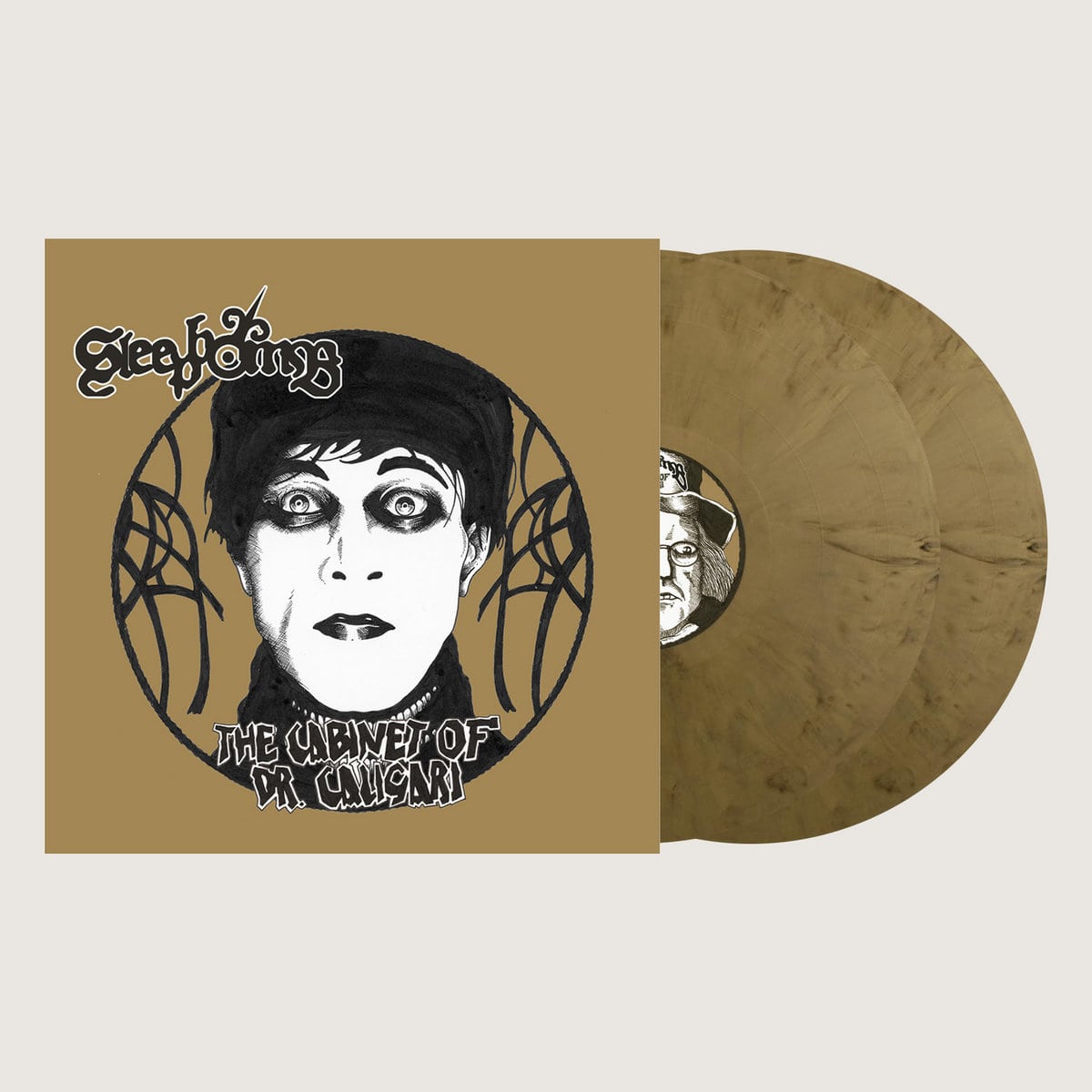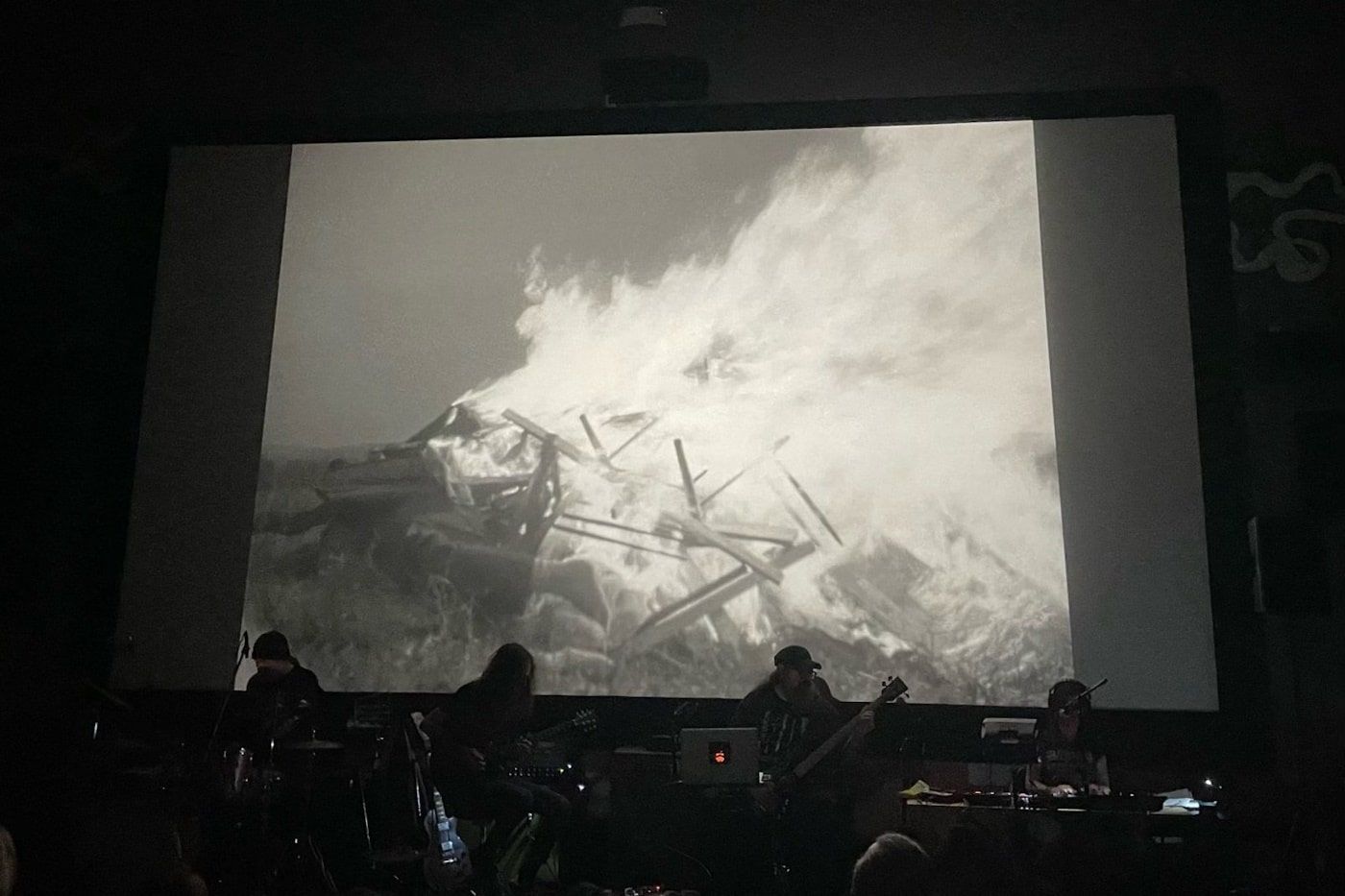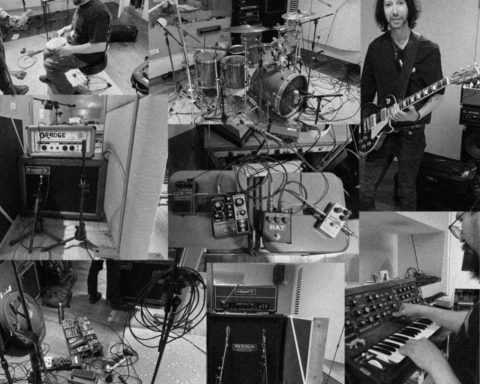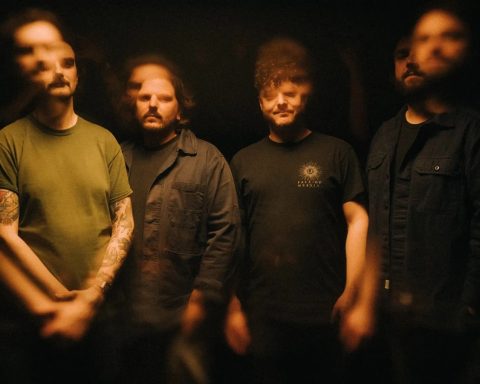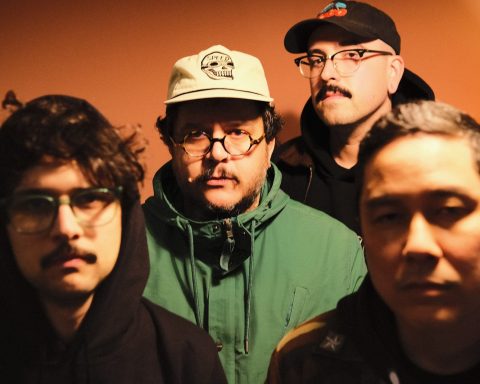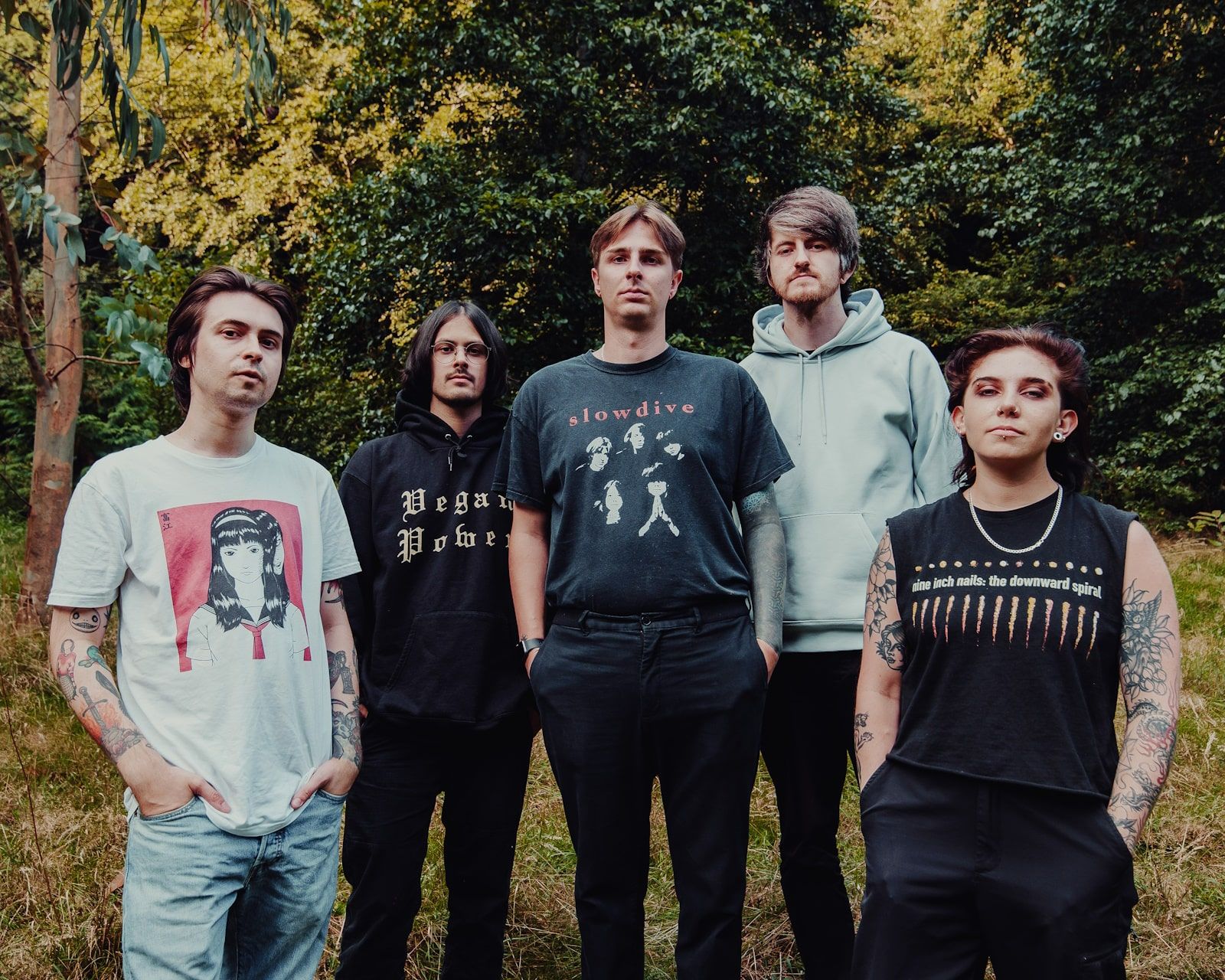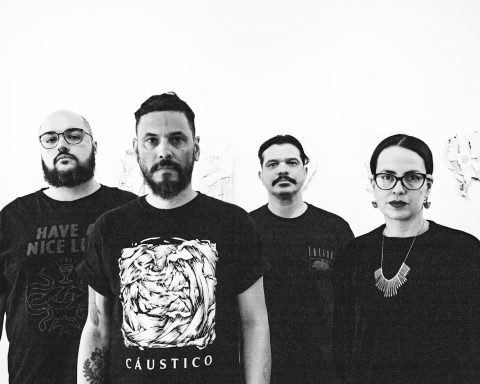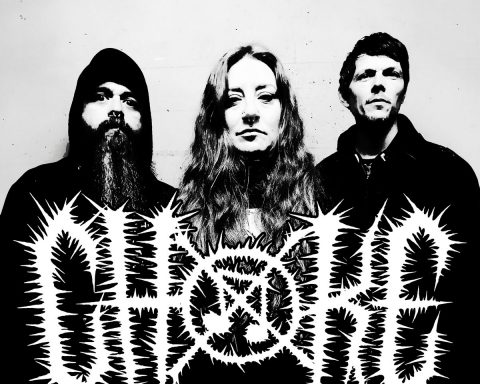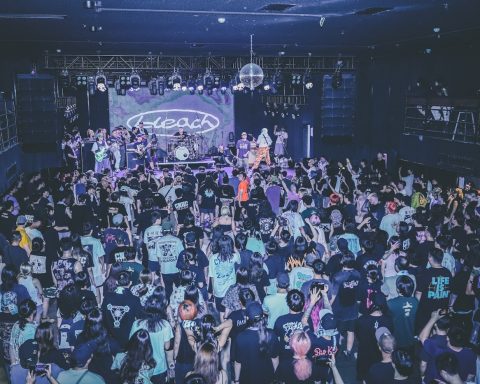San Francisco-based drone/doom-metal band Sleepbomb have unveiled their captivating new score album, “The Cabinet of Dr. Caligari,” set to release on November 3 via Koolarrow Records / Consouling Sounds. With roots deep in the experimental, Sleepbomb’s newest creation transports listeners into the haunting realms of German Expressionist cinema, providing an auditory experience that’s as cinematic as it is musical. Today, we’re diving deep into their craft, with a special video premiere and in-depth interview revealing the dark corners of “The Cabinet of Dr. Caligari”
The album marks a landmark of silent cinema, known for its gothic, chaotic, and expressive aesthetic.
Claire Hamard, contributing her evocative vocals and synths to Sleepbomb, shared her first encounter with the film.
“I was completely captivated by its gothic, chaotic, and highly expressive aesthetic. I wanted to convey the strange beauty that emerges from it, over and above its sometimes disturbing or even terrifying aspect,” she says. The band’s improvisational ethos resonates deeply with German Expressionist films, creating a bond between visual narrative and auditory experience.
Tim Gotch, a core member of Sleepbomb, discusses the transformative nature of their recontextualized scores. He emphasizes that “Sleepbomb is scoring the picture, rather than just using the visuals to support the music.” The deliberate attention to pacing, tempo, and scene dynamics ensures the music isn’t just an accompaniment but an integral part of the storytelling experience.
The band’s journey since its 2003 inception has been a fascinating evolution. From its early days of improvised industrial/experimental scores to its present-day fusion of drone and doom metal, the band members bring a myriad of inspirations to the table. This includes influences from iconic bands like Godspeed You! Black Emperor, Coil, and Neurosis.
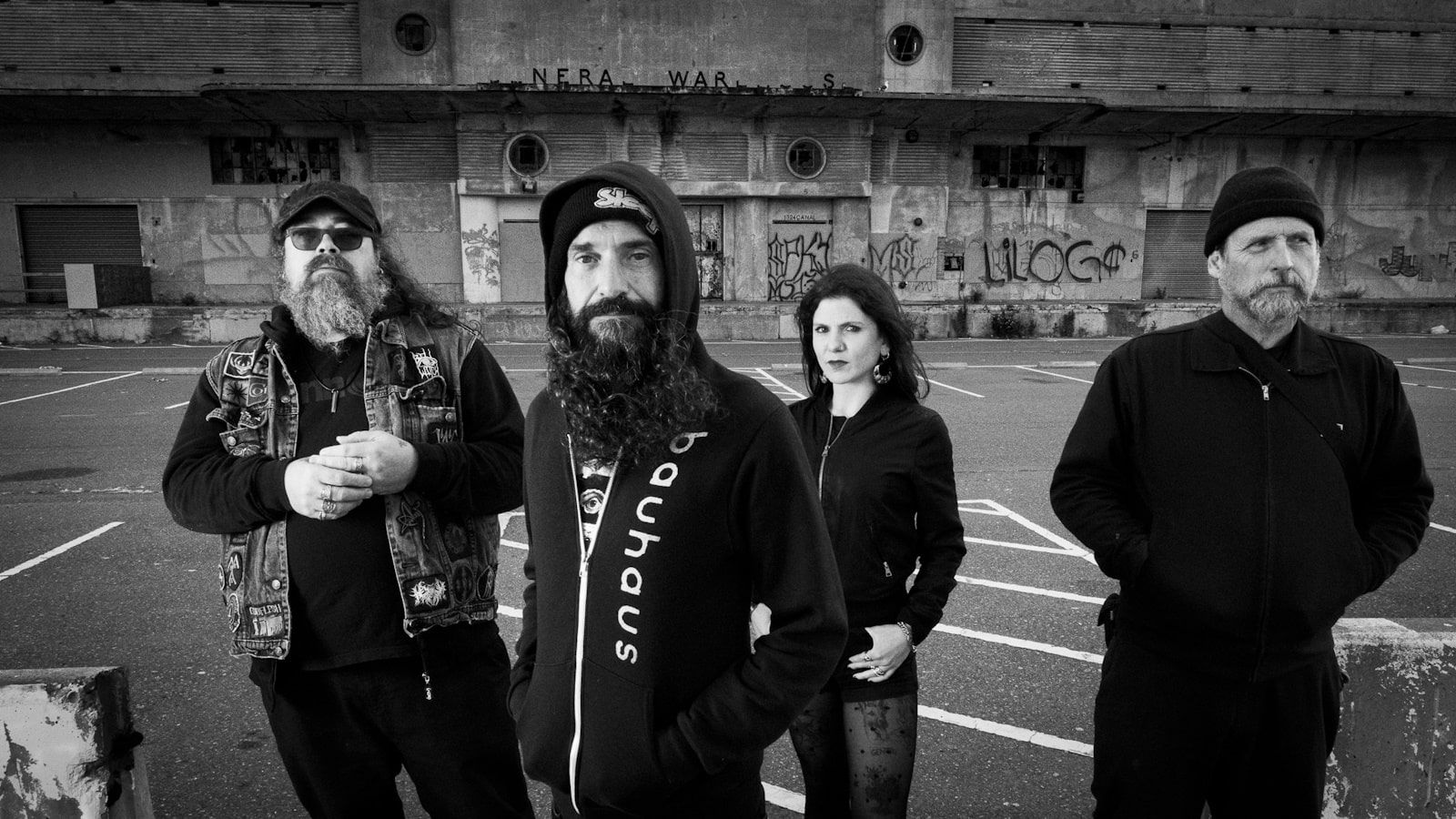
An intriguing aspect of Sleepbomb’s soundscape is James Presley’s use of a saw, adding an unconventional timbre to the band’s already diverse palette. The San Francisco Bay Area, known for its eclectic art scene, has played a pivotal role in the band’s evolution. Their performances across various local venues, theaters, and art galleries have not only shaped their musical direction but also deepened their connection with the community.
With the release of ‘The Cabinet of Dr. Caligari’, Sleepbomb is embarking on a tour, including dates at Kilowatt in San Francisco and Clinton St Theater in Portland. Attendees can anticipate an immersive blend of visual and sonic artistry, with CD and BluRay versions of the album available exclusively at the tour venues.
Sleepbomb’s journey through the world of film scores has been marked by growth, transformation, and a commitment to creative exploration. As they look to the future, fans can eagerly anticipate the band’s next venture into the world of cinema and sound.
Can you talk about your first encounter with “The Cabinet of Dr. Caligari”? What about its aesthetics and narrative drew you to consider it for Sleepbomb‘s next project?
Claire: When I joined Sleepbomb last year, Dr. Caligari was the second film I worked on with the band, after Night of the Living Dead.
It was very interesting, because while Night of the Living Dead follows very contemporary filmic codes, with alternating moments of fairly brutal action and rest, Dr Caligari offers a completely expressionist vision of cinema. It’s no longer a question of giving the viewer the impression that they’re living the scene, and of providing them with intense, explicit emotions, but of aligning with the impression of doubt, of weirdness, of a form of absurd, intriguing gothism.
This encourages us to think about communicating impressions rather than reactions.
The band has a history of performing improvised scores to German Expressionist films. Why do you believe these films, in particular, resonate so deeply with Sleepbomb’s musical ethos?
Charlie: When Mark and I first started the band, we not only spoke about what influenced us in music, but also in film. Mark mentioned to he had gotten together with an old collaborator to perform to Metropolis., so early on in the process we decided that we wanted to join music with film and the movies from that era were perfect for us. They offered films that have emotional weight on darker subject matter (dystopian futures, horror, insanity) that not only fit our sound, but also were ready for a more modern take sonically.)
Tim: The German Expressionism oeuvre has been a great vehicle for Sleepbomb for many reasons. Firstly, aesthetics. These films feature a stylised design sense that not only match the vibe that we’re trying to attain, but also makes for interesting viewing from an audience perspective. Secondly, story and plot. These films are good films in and of themselves, with quality writing and character development that, as Charlie mentions, carry an emotional weight on the oft heady topics on hand. Thirdly, their status as public domain films makes working with them considerably easier from a rights perspective. For our somewhat unconventional process, while this aspect is not required from a film for us to chose it as a vehicle for a score, it certainly helps. Overall, the German Expressionist films are ideal for our purposes.
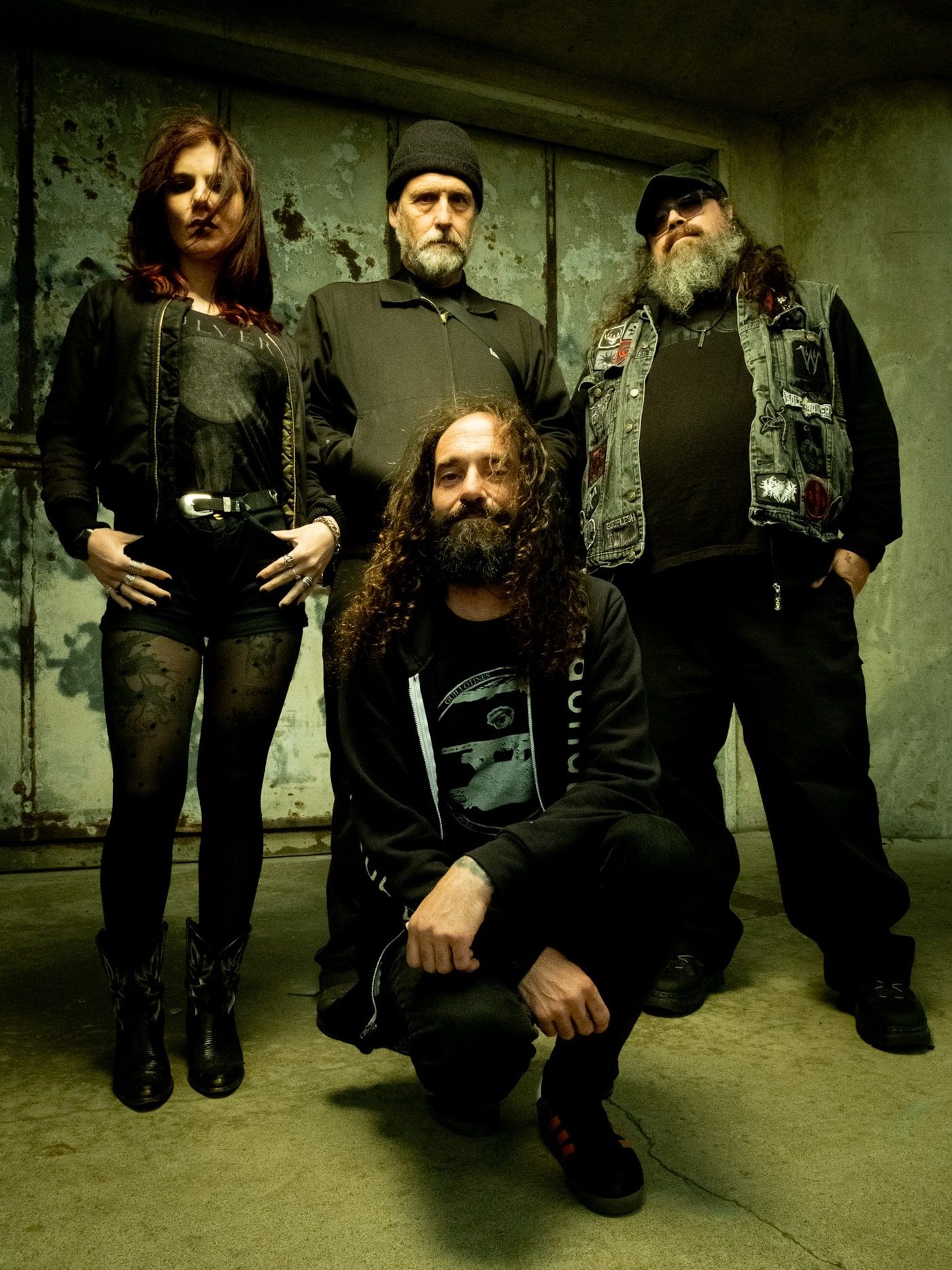
Tim, the experience of watching a familiar film with a recontextualized score seems to be transformative for many. What do you believe is the secret ingredient that gives Sleepbomb’s soundtracks this unique dimension?
Tim: I’m not sure if it’s a secret, as it is well known that music has a great impact on how a scene is processed by the viewer of a film but I think that Sleepbomb’s specific aural aesthetic does contribute directly to this effect in a way that many viewers do not expect. Many audience members may not be coming into a Sleepbomb screening from heavier/darker music scenes, and the music is definitely a bit outside the normal “live film music” scene (not to take anything away from that area, as there’s lots of great music there) so they are experiencing something entirely new, forcing their minds to re-evaluate the materiel as a whole.
This is most evident in the case of Night of the Living Dead and Conan the Barbarian where there are already somewhat iconic pre-existing scores in the original for the audience member to compare and contrast, but has also been received as feedback around the silent films.
The term “meticulous collaboration” was used to describe the making of ‘The Cabinet of Dr. Caligari’. Can you shed some light on the most challenging and rewarding moments of this collaborative process?
Charlie: ”I really enjoyed the writing process for Caligari. We created our new writing process, where Tim and I would get together and write out parts before presenting them to the rest of the band to add their ideas. The one challenge I saw was that after performing the score a couple of times, we realized that there were parts that didn’t quite fit or should be re-written. These were also some of the most rewarding moments, because I’m very proud of what came from those sessions and I feel that they enhanced the score and made it more complete.
Tim: Pretty much what Charlie said. Prior to the pandemic, we did almost all of our writing by jamming in our rehearsal space as a group, recording those jams and then developing what we liked afterwards. This did not work during the pandemic, to say the least, as we were very careful during the lockdowns and afterwards, and there were no good online tools that worked for us to collaborate. When we got back to work after the pandemic, this combined with the smaller lineup caused us to change it to a more focused process. Next year, when we start working on new material again, we will likely return to a certain amount of the “jam” style writing as well.”
Tim, you emphasized the importance of tempo in scoring for films. How challenging was it to time ‘The Cabinet of Dr. Caligari’ so that the score lined up perfectly with the narrative beats?
Tim: There are several aspects of tempo and timing involved when working with a film. First off, there’s just the gross beats of the films that need to be hit (scene changes, specific emphasis points, etc.) This often determines the tempo of a segment and must be adhered to somewhat stringently, as the film does not stop to wait for us to catch up!
We do not currently rely on a click track or sequenced rhythmic elements, so this can be tough to nail on a consistent basis without a lot of rehearsal. Once you get away from the actual timing of the film, then it delves into the nuances of the scenes, where the music’s feel and various elements need to hit the timing that we’d like to see with the picture. This is easier with a film like Caligari, where there are no dialog elements to work around.

Sleepbomb has evolved stylistically over the years, drawing inspiration from a myriad of iconic bands. How do you strike a balance between drawing inspiration and maintaining originality?
Charlie: Sleepbomb from the beginning has marched to its own drummer. We’ve always seemed to be able to take what inspires us and then add our take. We write from our hearts, so even though you can hear what influences us, it always sounds like Sleepbomb.
Tim: As Charlie mentions, Sleepbomb is Sleepbomb. A critical component of the band has always been a “anything goes” vibe, both genre-wise and around instrumentation and sound. In many ways, Caligari is actually our most conventional work in the repertoire, being fairly short and focused around mainly doom song structures. Other scores range broadly in their tone and genre, ranging from hardcore to synthwave to ambient.
We often cite GodSpeed You! Black Emperor being a major influence, but they are an influence in the sense of feel and dynamic range and crescendo, not so much in regards to the actual music. Similarly with Swans, Sunn 0))), Earth and others. We worship at the wall of sound and repetition (and volume!) with these groups but we don’t sound any more like them than each of them does to each other.
Charles, since you were part of the original foundation, how do you perceive the evolution of the band’s sound and dynamics since its inception in 2003?
Charlie: The two biggest steps we’ve made came at the same time. The big one was to move away from improv to a pre-written format. Once we made that decision, we started leaning more on our metal influences and it allowed us to craft pieces of music that carried more emotional weight.
Claire, diving deeper into the techniques, how do you approach the task of layering vocals with the more dissonant and haunting harmonies, ensuring they complement the visuals of the film?
Claire: It all depends on the mood of the scene. Above all, the dissonance creates an auditory uncertainty, the expectation of a resolution that doesn’t necessarily appear in the melody or the film. There’s a kind of ghostly aesthetic, which doesn’t always meet the listener’s or the viewer’s expectations, but which offers a kind of beauty when considered as a whole. On a technical level, I work a lot with relatively arrhythmic and very stretched loops that I sometimes harmonize, and to which I add echo and resonance effects.
With the fusion of genres that Sleepbomb explores, from drone to doom metal, how does each member contribute to ensuring cohesion within this vast soundscape?
Charlie: Sleepbomb has been the shared vision of Tim and myself. We’ve been the core of the band, both musically and visually. Space has always been a part of us musically, so there’s always been room for other bandmates to find their lane.
Tim: As Charlie mentions, the current arbiter of the band’s music is primarily driven by our aesthetic. We maintain a certain vision to the sound that keeps things “Sleepbomb” but are open to any and all suggestions from other members of the band. Sleepbomb is not a dogmatic venture in this sense, it’s much more about feel than conforming to genre expectations or a singular vision.
Claire: I’m a metalhead myself, but paradoxically my contribution here is a bit different. Tim, Charlie and Rob stand on their own as a metal band. By adding keyboards and vocals, I’m trying to bring in something that isn’t what they’re already doing, i.e. an approach that doesn’t alter their aesthetic choices in any way, but perhaps opens up other possibilities. These can range from bringing a dramatic (or cinematic) touch to a scene, to harmonic enhancement or sonic textures for another.
The band has a significant connection to the San Francisco Bay Area, performing at various venues. Can you describe the influence of the local scene on Sleepbomb’s musical and performance evolution?
Charlie: I’m proud to represent the SF music scene. It has a rich history and we’re part of it’s diversity. I see a line that you can trace from us to Faith No More to the Bay area thrash scene to the Grateful Dead. SF has always welcomed diversity, innovation and quirkiness, and I feel like we encompass that.
Tim: San Francisco and the Bay area have always been open to weird experiments in art. We’re lucky to be in a place that accepts what we’re doing, even if they don’t understand it at first, rather than in a location where it is a struggle to even get a response, let alone an audience.
Given the multifaceted nature of the band, with members partaking in sound design, film editing, and technical aspects – how do these diverse roles shape the way Sleepbomb approaches a project?
Charlie: Due to the work involved, we pick films that resonate with us. Each score is a labor of love and with the work that not only goes into writing, but also the film’s technical aspects, it has to be a film that hits us emotionally.
Tim: The technical aspect of the work is key in providing flexibility and keeping things fresh. I have a background as a filmmaker and sound editor and perform the majority of the film related editing, sound design and technical items, but everyone contributes with constant feedback on what’s working and what might need to be changed to provide the best experience. Each film generally goes through several iterations technically to arrive at it’s final state and it is rare that we can call something 100% final for at least a year or two after it’s debut as a live show.
Sleepbomb’s live performances have been noted as both enthralling and captivating. With the upcoming tour dates, what can attendees anticipate in terms of the visual and sonic interplay during these shows?
Charlie: Attendees will be able to see these classics through a new sonic backdrop that enhances the emotion and mood of these films.
Tim: For a film screening, Sleepbomb is in the role of an orchestra. We are not the focus of the experience, and it may even be difficult to see us in the dark. The goal is to perform a score for the film and to enhance the cinematic experience.
The band took a hiatus in 2013 and underwent some lineup changes before fully reuniting in 2015. What prompted this reunion, and how did these changes influence the band’s dynamic?
Charlie: The reunion came to be for two reasons. First, Mark spoke about how much he missed crafting together and second, we had a lot of people asking for more. Until that point, we didn’t realize how much people enjoyed what we were doing and once we saw how much we had touched people, we decided to get back into it.
Once we got back together, we had a new bass player and it was when Tim and I started writing together and decided to go for a more doom influenced sound. Mark left soon after and Tim and I have run the band since.
Tim: When Sleepbomb (the casual improv project) reunited in 2015 for the reasons Charlie enumerated above, it was initially just as a slightly new version of the casual project. We had a new bassist, Matt Pankuch, and I was still doing synths and electronics, but it was a similar idea as before. Mark was very busy with his professional life though, and Charlie and I wanted to play on a more regular basis. We did, and it eventually got to the point where we wanted to do more shows.
Mark had to stop entirely after a year or so to focus on career and family, and then Matt moved away shortly afterwards (though still remaining involved with the band on horns and percussion for Conan) and I took over the bass role. At this point, we really formalized things around the current core of Charlie, Rob and myself, along with saw player James Presley.
We went through a variety of other musicians (primarily second guitarists, who we like to think of as our “Spinal Tap” position) and had a pretty consistent lineup until after the pandemic. While we didn’t lose anyone during Covid itself, once we returned to regular activity, we went from a 6 piece to a 3 piece within the space of 6 months and were feeling the hole that losses had left in the sound, especially James and his saw.
Serendipitously, shortly after this I met Claire at our rehearsal studio (when she was there for a drum lesson from our neighbor) and she joined shortly afterwards as a really excellent addition, which eventually leads us to today!
Lastly, with such an intricate and involved process for creating these scores, what’s next for Sleepbomb? Are there other cinematic masterpieces on the horizon you’d like to reimagine?
Charlie: I’d love to rescore John Carpenter’s The Thing! It’s such a perfect movie for us. I love the original, but Carpenter’s version is such a masterpiece. It has all the ingredients for a Sleepbomb redux. Moodiness, it’s unsettling, it’s SciFi/horror and it’s visually stunning.
Tim: While The Thing would be awesome (though respectfully replacing a Morricone score would be a huge task, as would dealing with the rights issues), we have a few things already lined up before we start up with a blank slate score!
Next up for the band is our score for George Romero’s Night of the Living Dead! We’re actively performing this score live right now and recorded all the drum tracks for the record during the Caligari sessions. We’re returning to Earhammer in December to complete tracking on this with the aim to release the score in mid-2024.
Following Night, we will be adapting our existing Nosferatu and Metropolis scores for the current lineup with the intent to record and release them in 2025. We also have our Conan the Barbarian score waiting in the wings for the same treatment, but it’s on hold right now due to rights issues.
That doesn’t mean that we won’t be writing new music though! Alongside the above items, we’re talking about writing some new material with vocals. We’ve recently played a couple of club shows where we revisited The Feast of Shivering Pain from our last record The Path of Pins with new arrangements by Claire and we feel that there’s a lot of opportunity there to develop some cool tunes.
Plus, it’s fun to be a regular rock’n’roll band occasionally!
Other films I’d like to do aside from The Thing are Piotr Kamler’s Chronopolis, Benjamin Christensen’s Haxan and Carl Theodore Dreyer’s The Passion of Joan of Arc. Beyond those, there are many, many other amazing films to draw on. Enough for a lifetime…”
Catch Sleepbomb live at the following dates:
10/17 – North Bend Theater, North Bend WA
10/18 – Johnny B’s, Medford OR
10/19 – Local 31, Ashland OR
10/20 – Clinton St Theater, Portland OR
10/21 – Northern Delights, Hayfork CA



